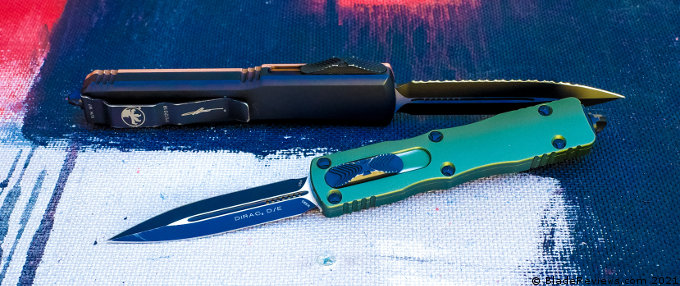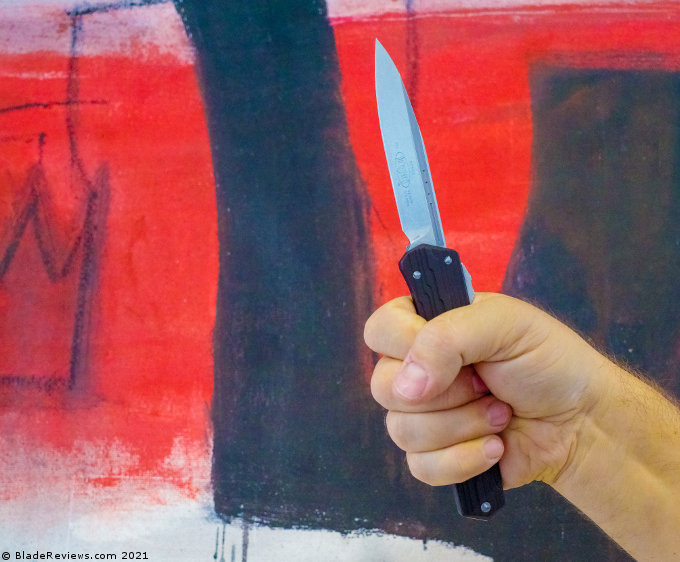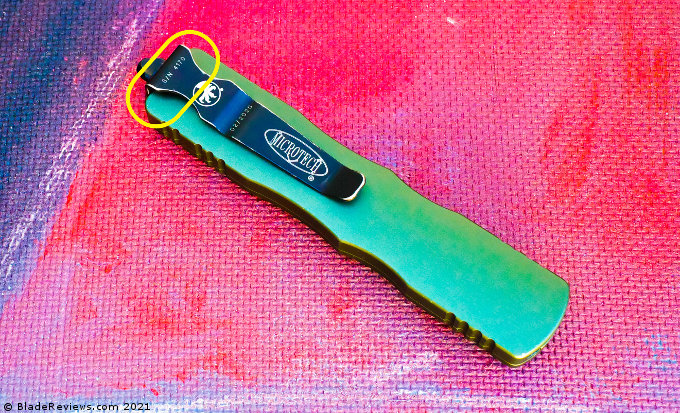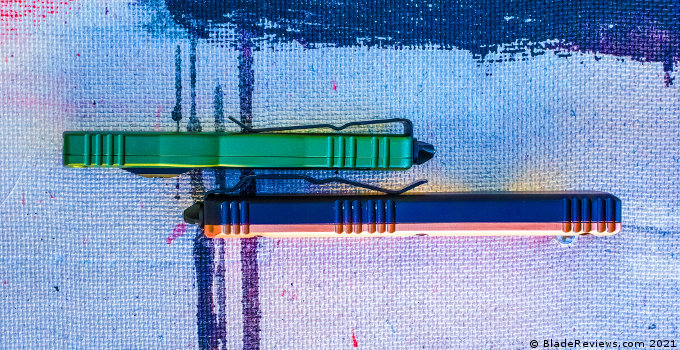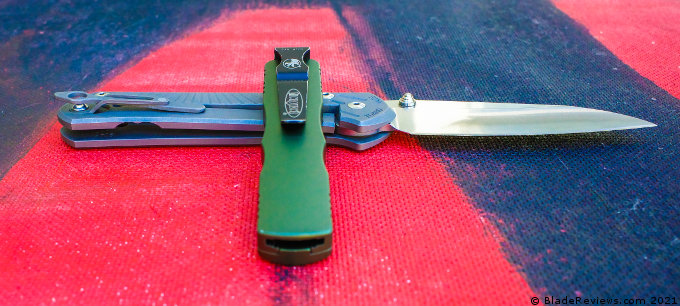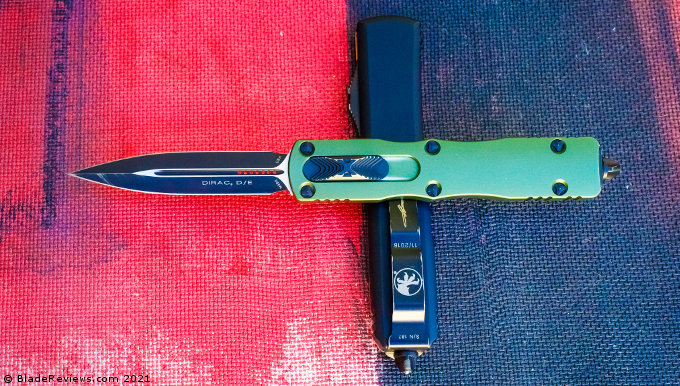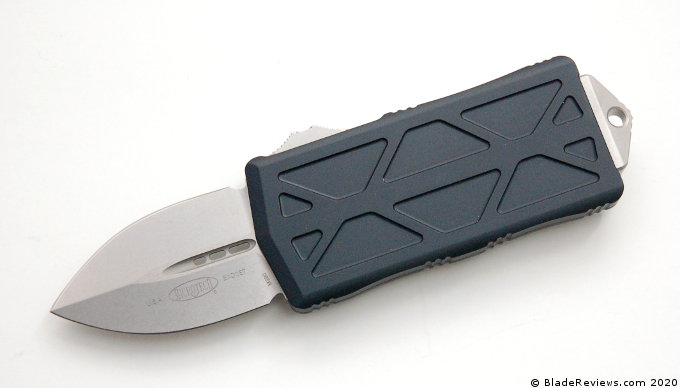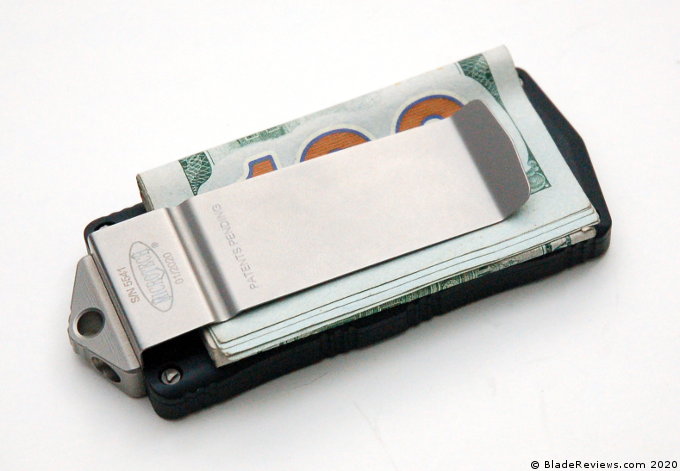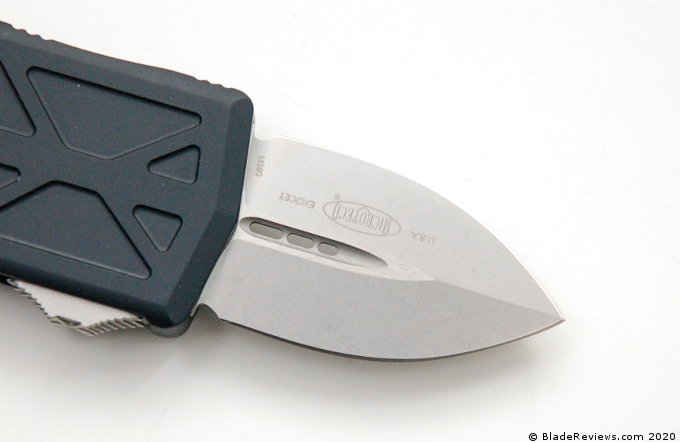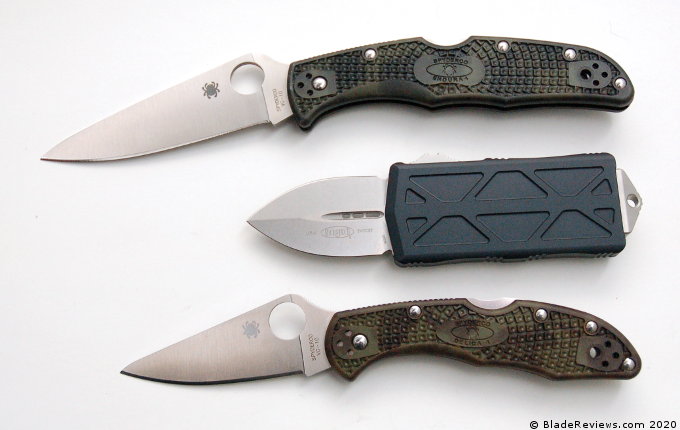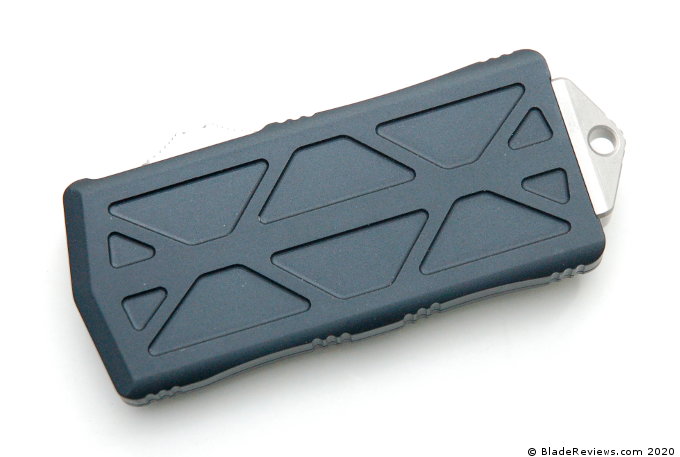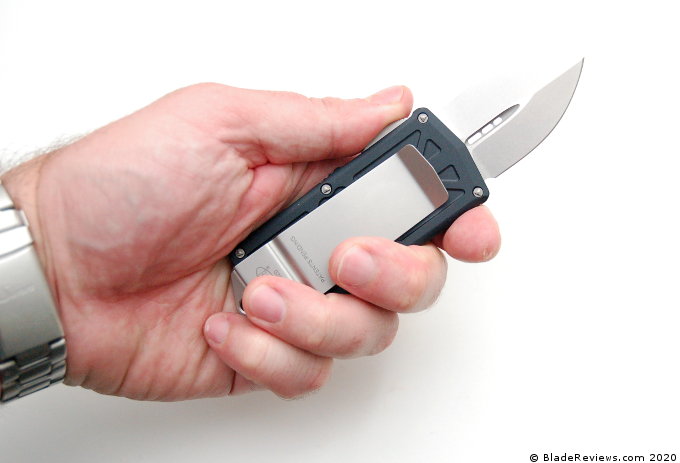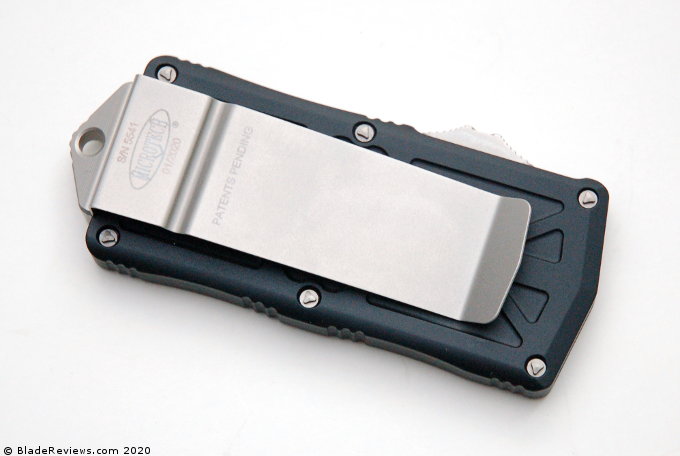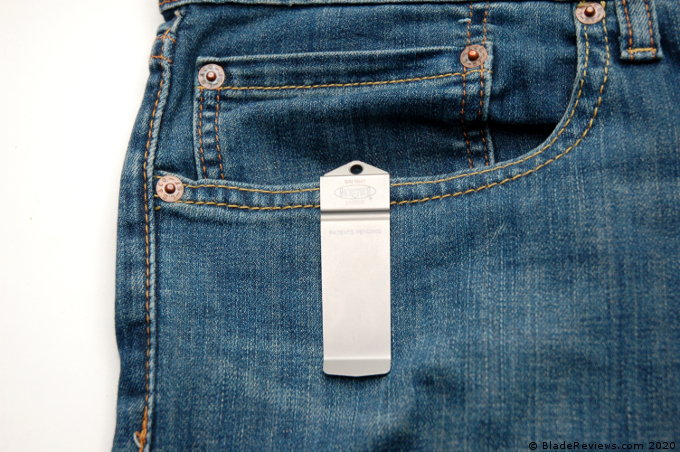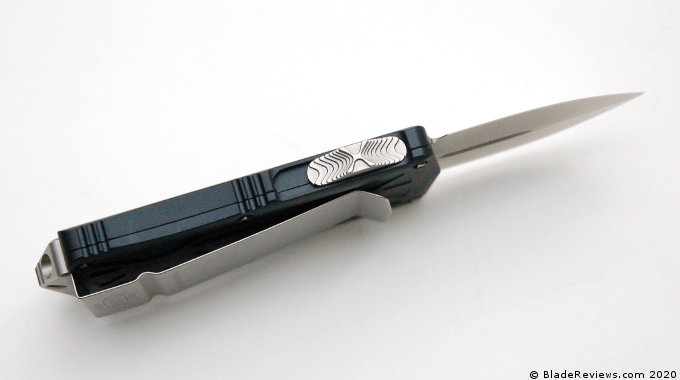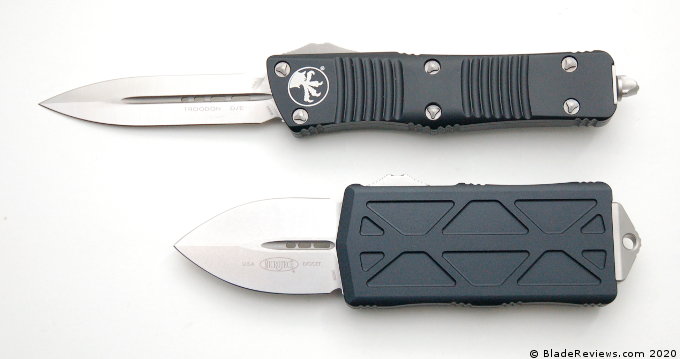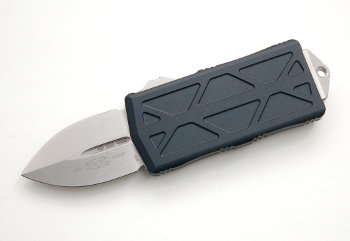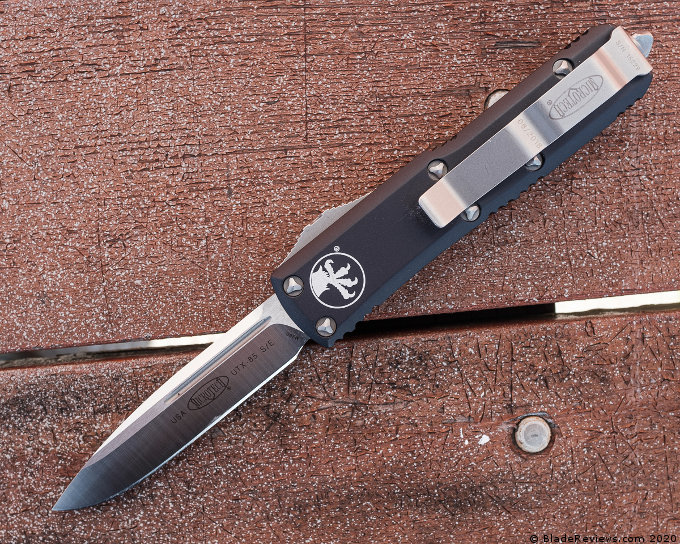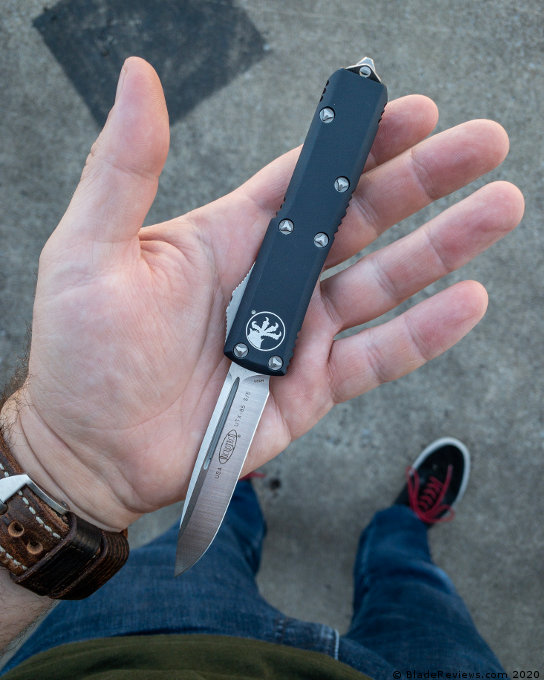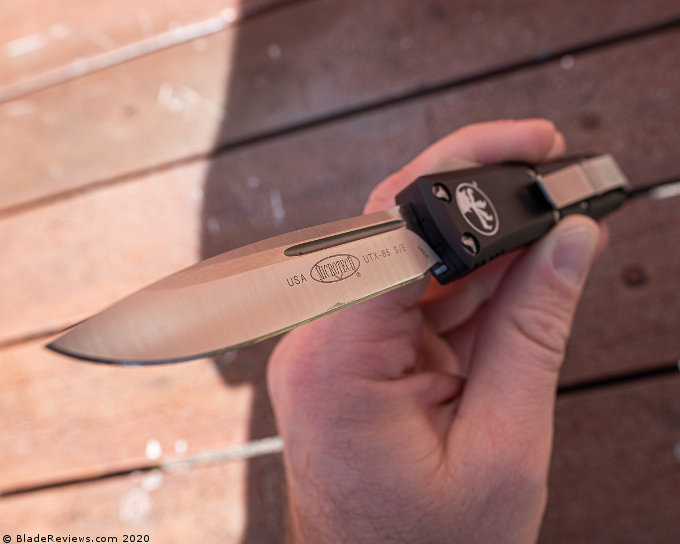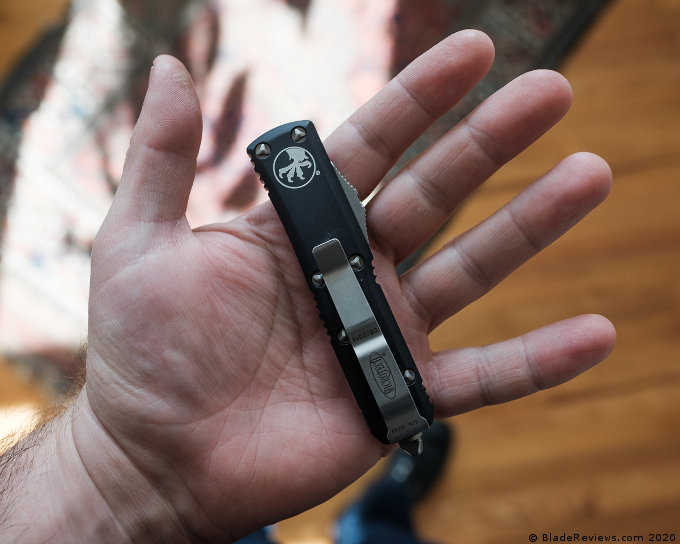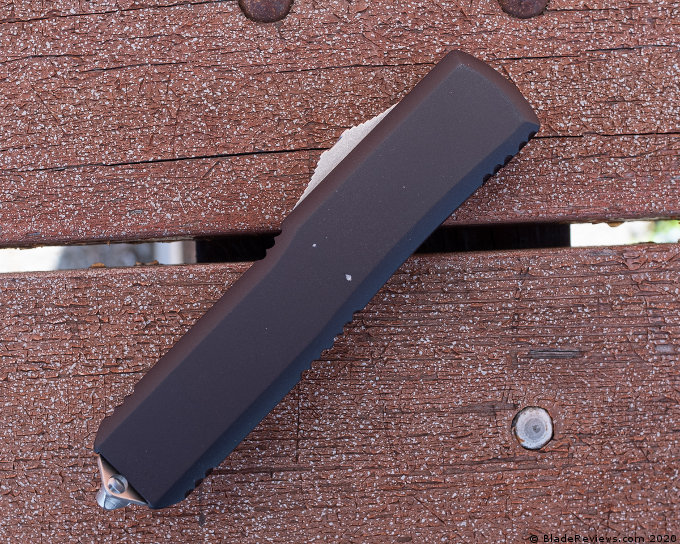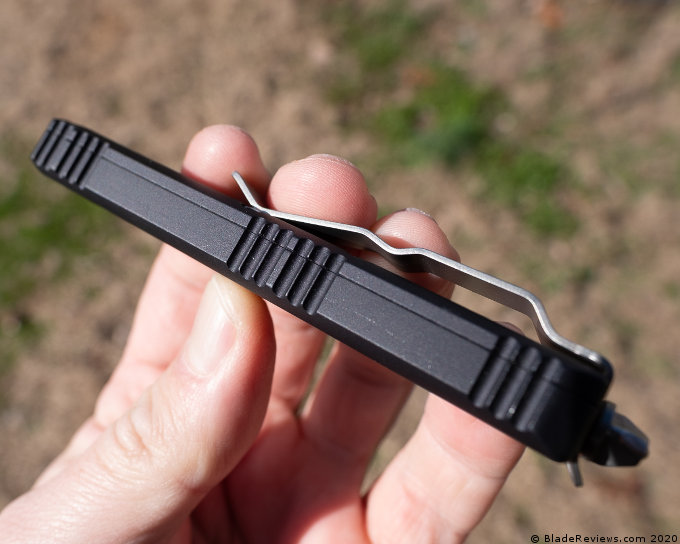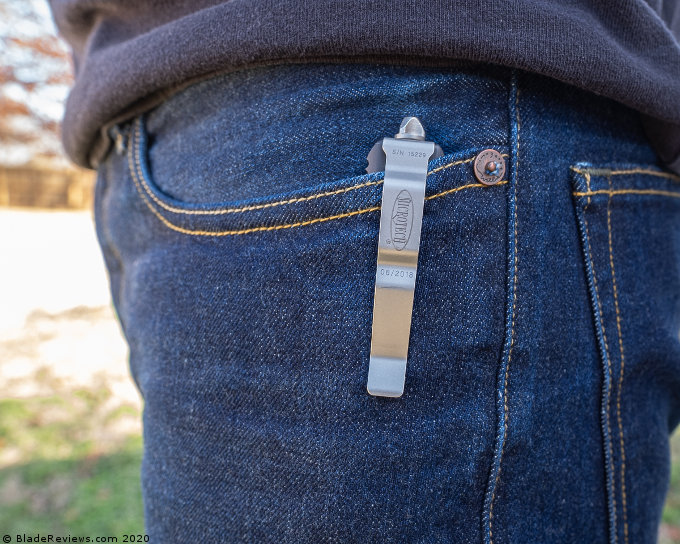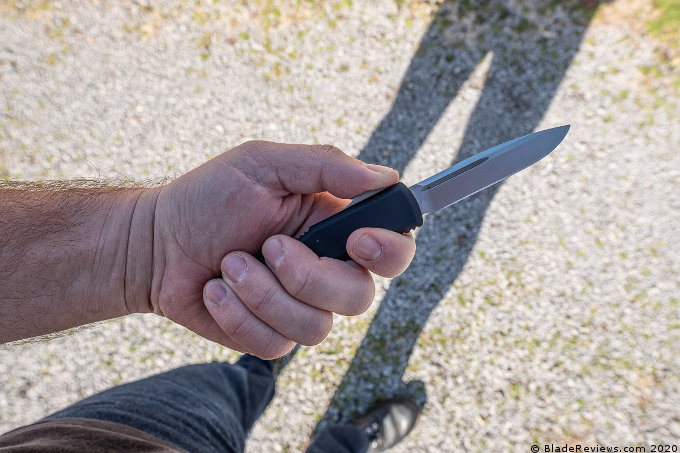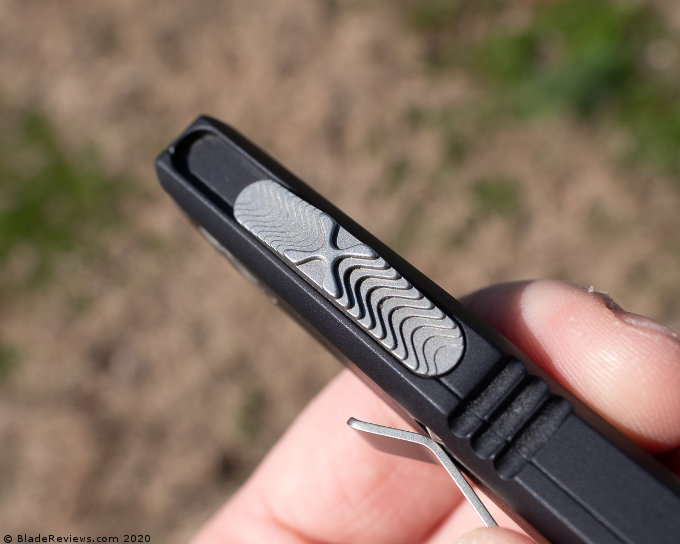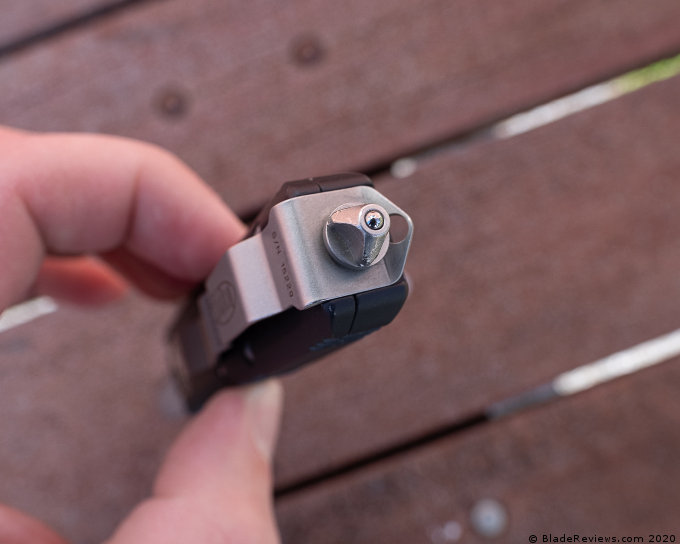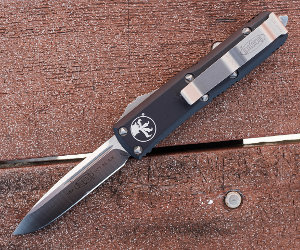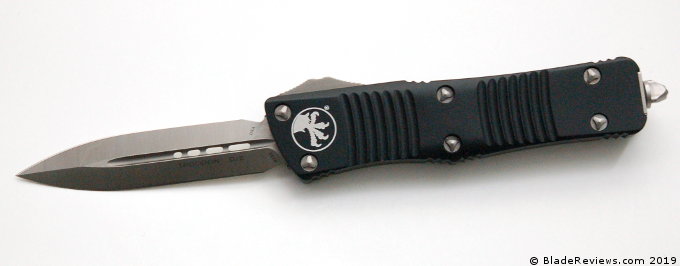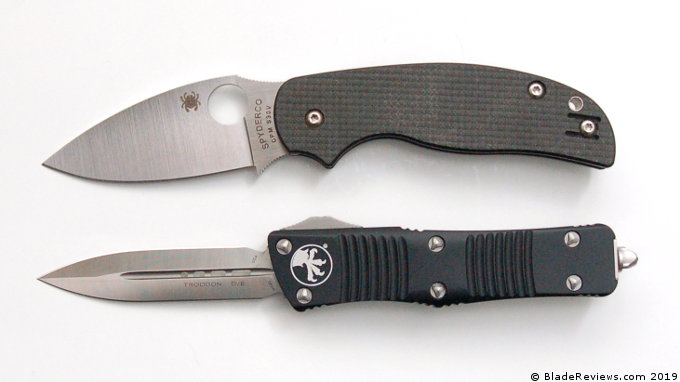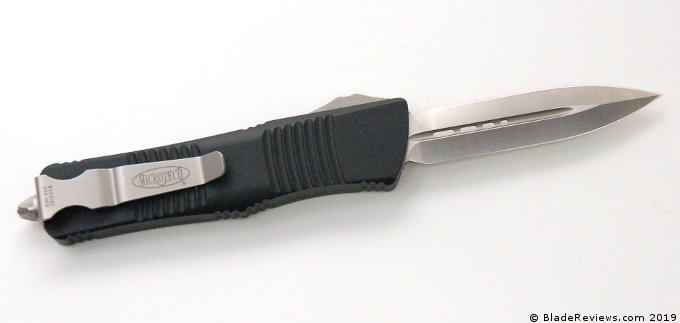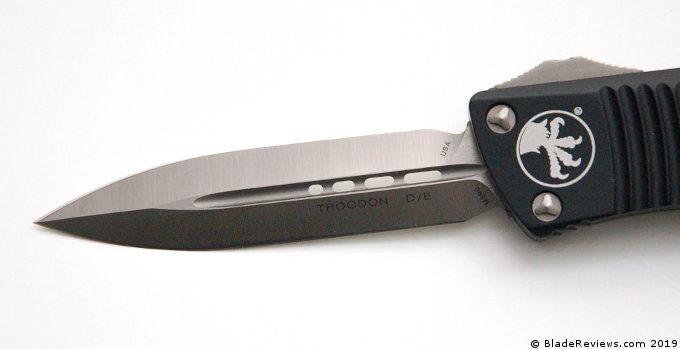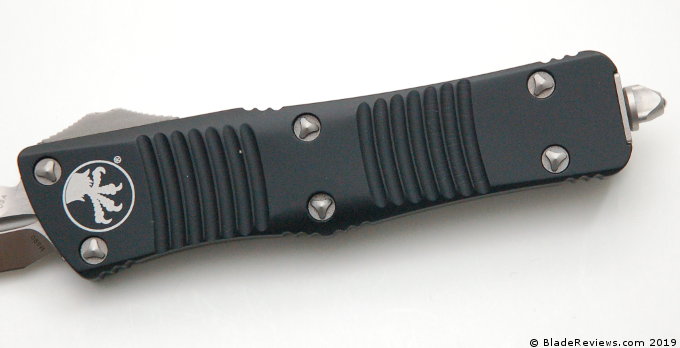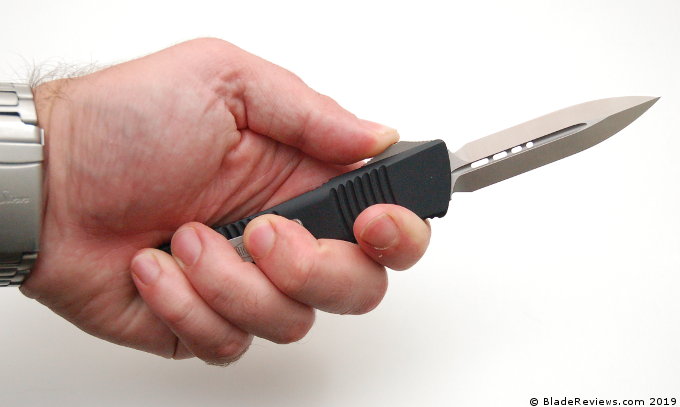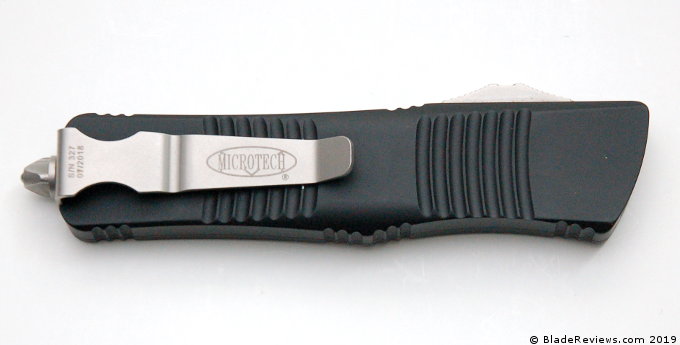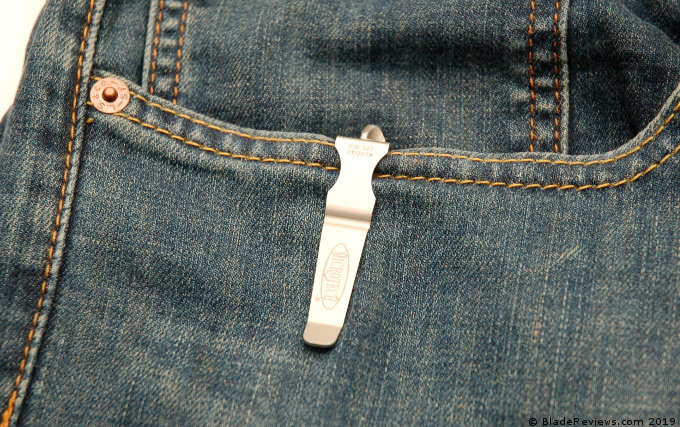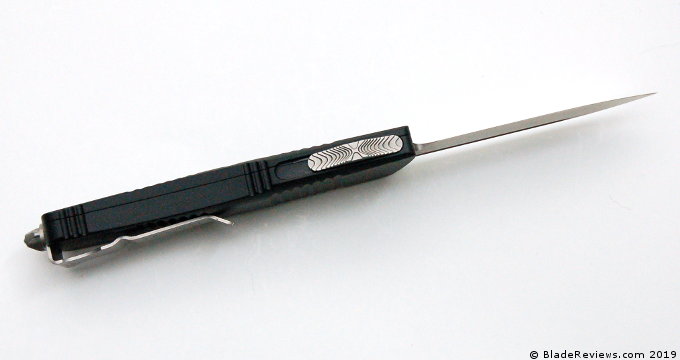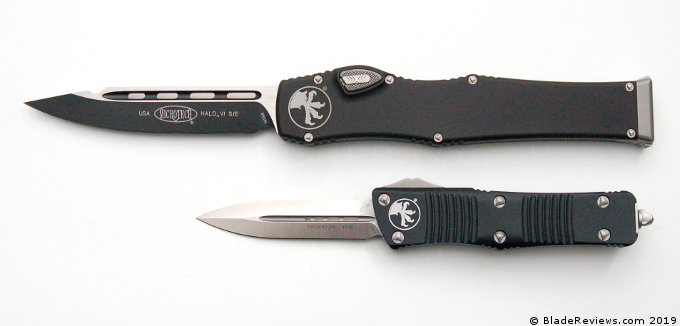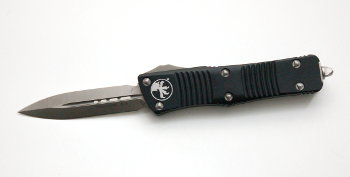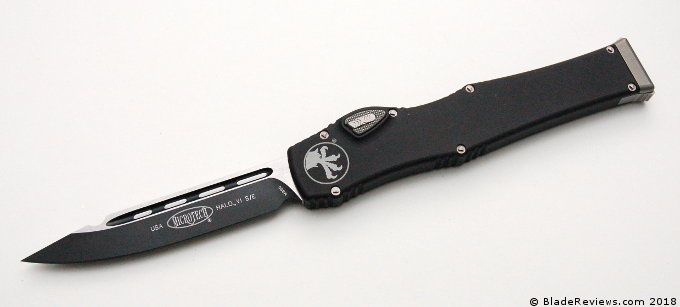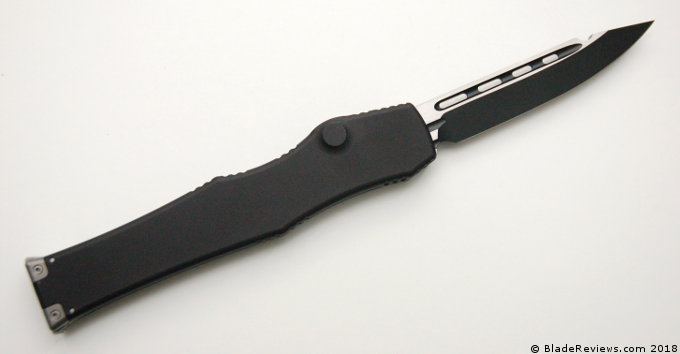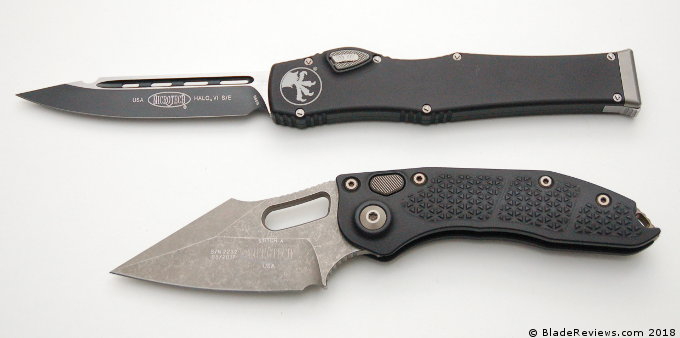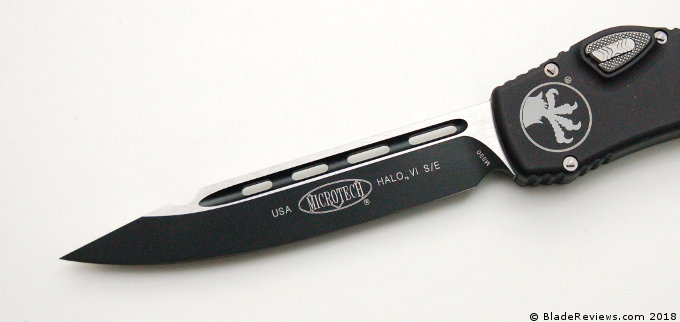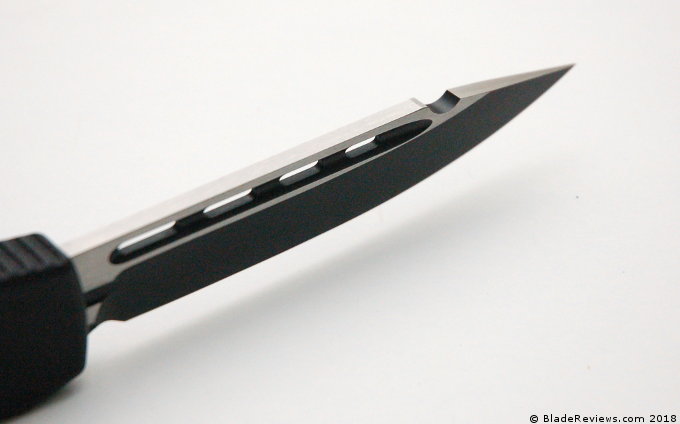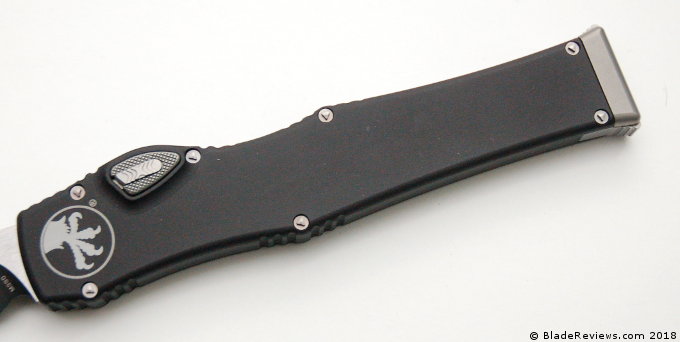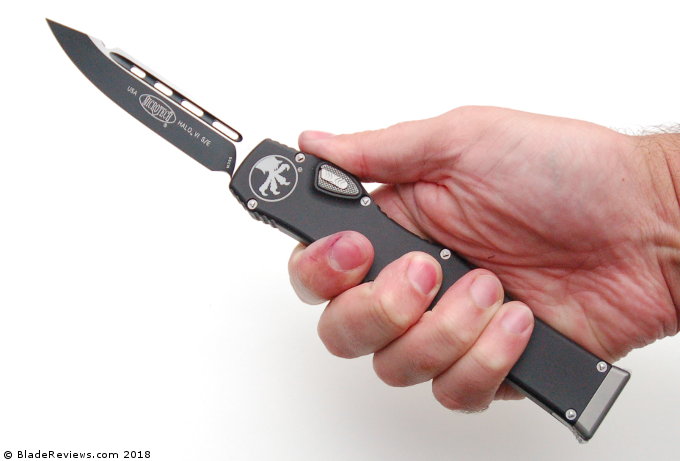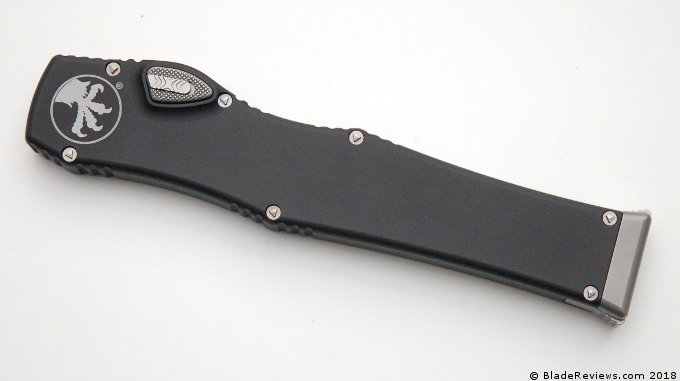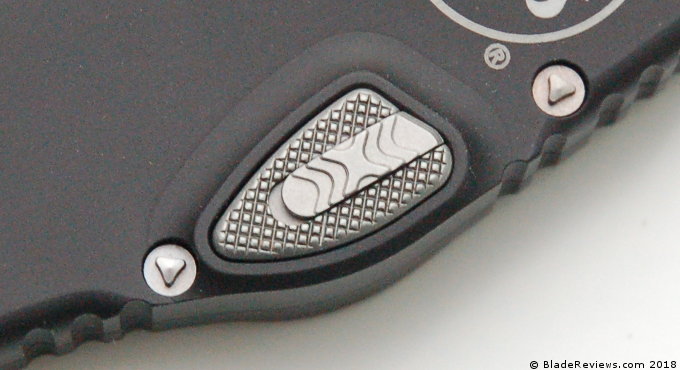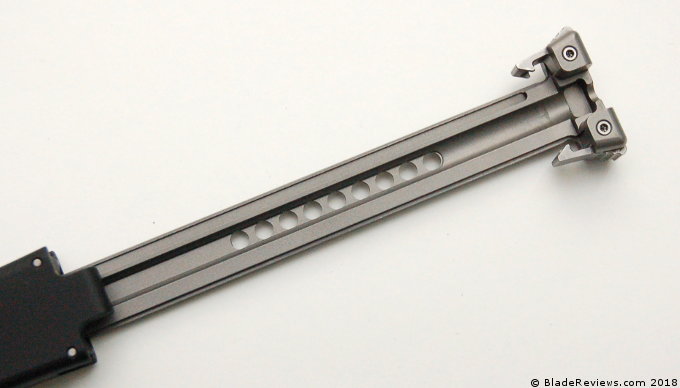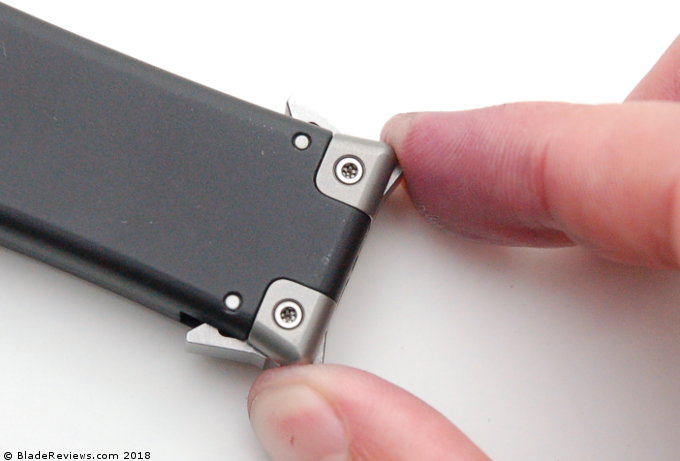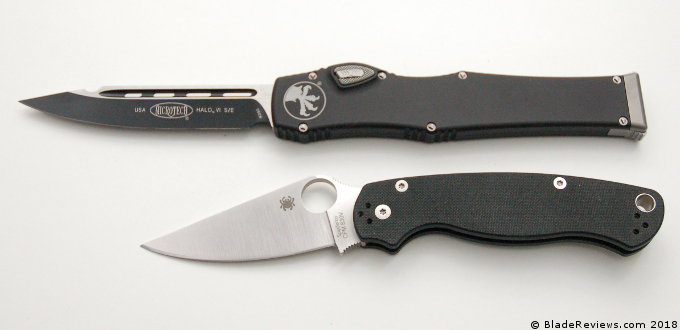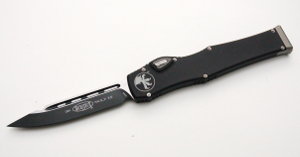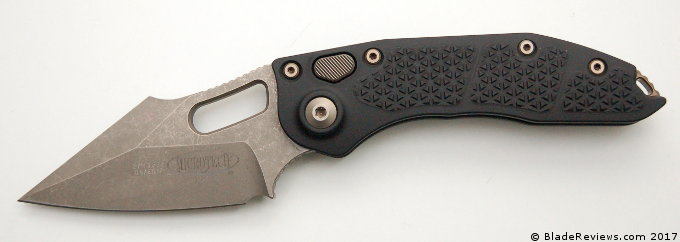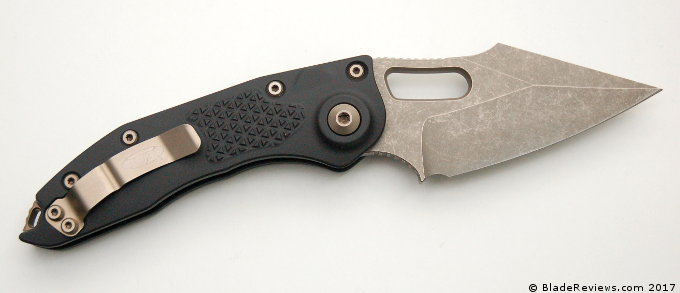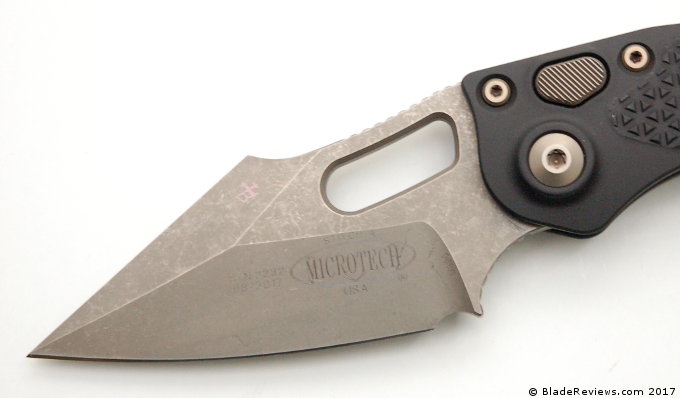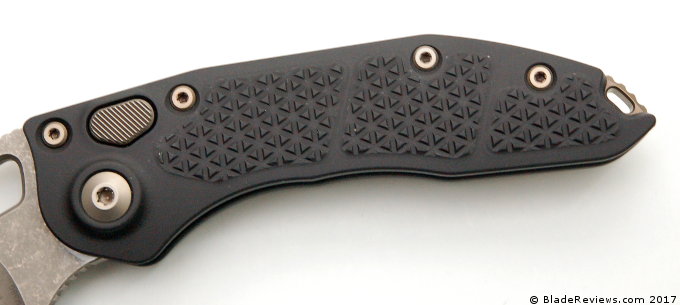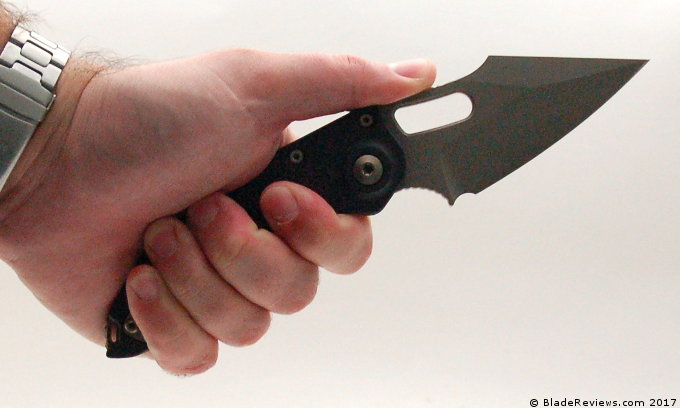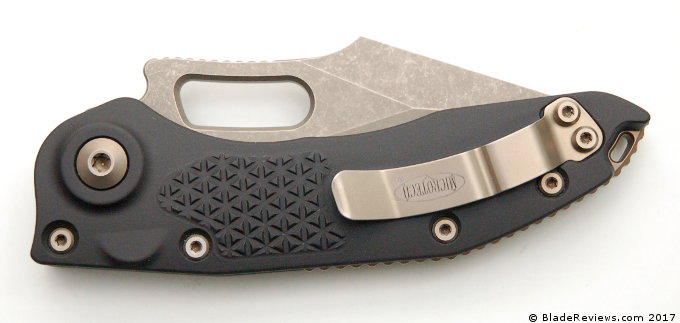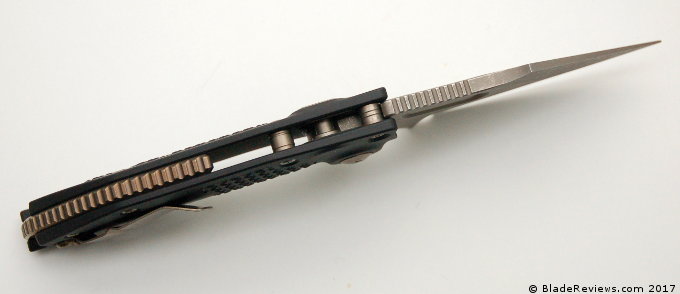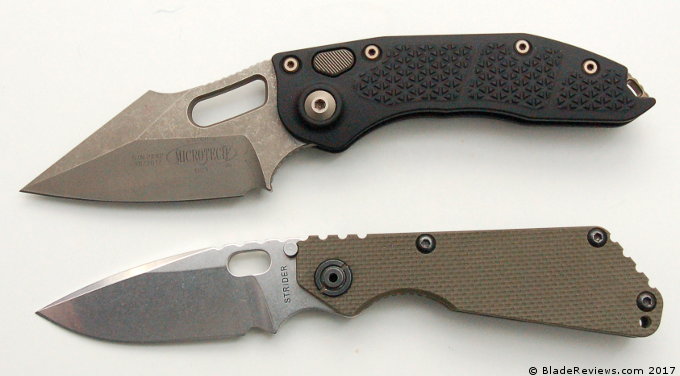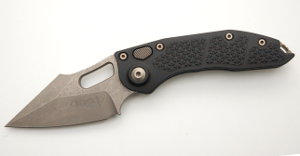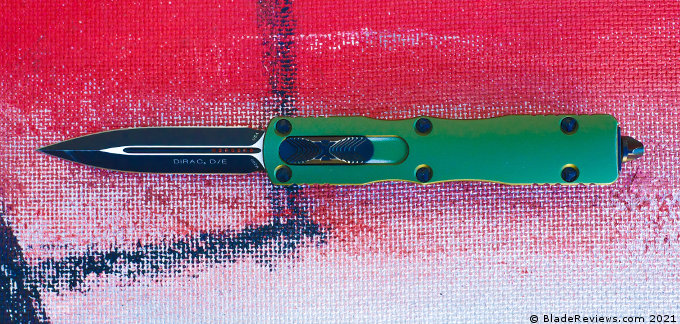
Buy the Microtech Dirac at BladeHQ
“Any sufficiently advanced technology is indistinguishable from magic.” (Arthur C. Clarke, 1962)
Every time I use my Microtech Dirac, I feel like I’m doing a magic trick. The Dirac is an out-the-front (OTF) switchblade, and its 2 7/8” (74 mm) blade snaps out and back in so fast that my eye can’t perceive the movement of the blade springing out of the handle- there’s no blur of motion, the blade just appears where there was previously nothing. I’ve been carrying the Dirac on and off for several months and I never get tired of watching it. I’ve also come to some conclusions about it as an EDC knife.
General Dimensions and Blade Details
The Dirac is a light, compact, stabby little knife. The blade is just over an inch shorter than the handle, which is 4” (102 mm) long, not counting its 9/32” (7 mm) glassbreaker. May I just add that the Imperial measurement system is antiquated and absurd, and I refuse to use it any more. The rest of the review will be using Cubits, notated as “cu”, with handy conversions into Biblical Cubits (Bcu) and Ancient Egyptian Royal Cubits (AERcu). The Dirac’s blade is a pretty handy EDC length of 0.162 cu (0.128 Bcu / 0.141 AERcu) and is quite thin at 0.0054 cu (0.0043 Bcu / 0.0047 AERcu) and the knife weighs a scant 0.00193 bushels. It’s obviously a thin, light knife that you barely notice in your tunic.

My Dirac has a double edge dagger-shaped blade made of Bohler M390 steel. M390 is a “super steel” made using a process called powder metallurgy. After reading a couple of very well-written articles on KnifeSteelNerds.com (thank you!) I think I can explain why M390 is so desirable for knife blades: small carbides. Powder metallurgy steel is made by heating iron, chromium, vanadium, etc. to a liquid form and thoroughly mixing it together. How finely ground the individual ingredients are affects how thoroughly it can be mixed together, and the goal is to eliminate big chunks. Have you ever not stirred pancake batter enough and gotten a lump of grainy batter in your pancake? Powder metallurgy pancakes would never have lumps like that. M390’s tight, homogenous grain structure makes it extremely hard (for sharpened edge retention) and pretty tough (resistant to chipping). Its tiny grain structure also enables it to be sharpened to a very fine edge. To sum it up, M390 is just about as good as it gets for blade steel in 2021.
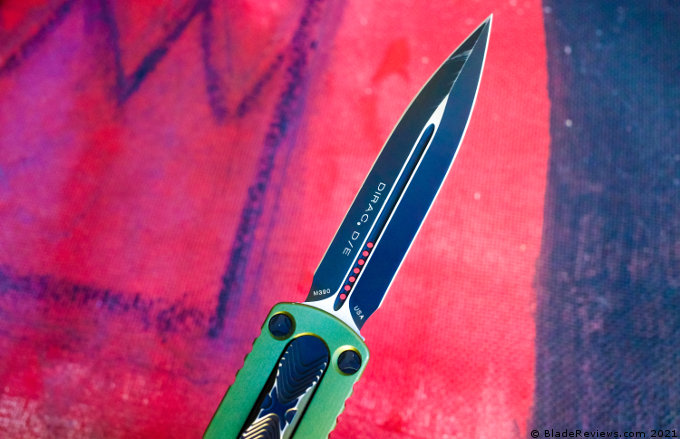
The Dirac’s blade has a black DLC (Diamond Like Carbon) coating, which I scratched cutting a cardboard box in the first week I had the knife. I have a few other non-Microtech knives with DLC coatings, and I never managed to scratch any of them. Maybe my DLC coated knives by Reate, WE, and Bestech and would have gotten scratched under the same circumstances, but I doubt it. Microtech’s DLC coatings are known to The Internet to get scratches and edge wear easily, and I can personally verify that. My Microtech Ultratech (aka my favorite knife in the world) looked just as worn-in after a few months of EDC as my Dirac does now.
The aluminum handles on both knives are scratched, the steel pocket clips have shiny edges, and the sliders (Microtech, like White Castle, calls ‘em sliders), have shiny raw metal showing where my thumb has rubbed the DLC off. I certainly don’t mind- I’m not a knife collector, I’m an enthusiast (aka knife nerd) and I think Jeeps and Microtech knives both look better with some dents and scratches. Microtech clearly agree with me that their knives still look good after some use, so they’ve done limited runs of most of their knives with a “distressed” finish. Microtech really took the distressed concept to the next level with their “Bounty Hunter” series, which are designed to look like knives that Boba Fett (a bounty hunter from the Star Wars films) would use.
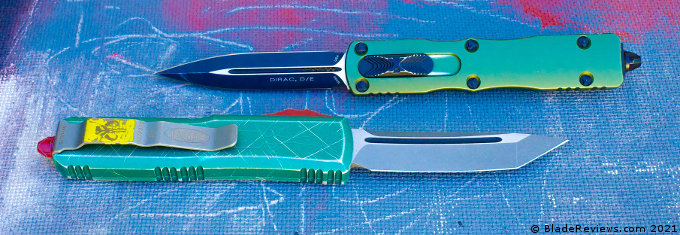
I’m sure these Bounty Hunter models were popular when they were initially released in 2016, but since the premiere of the Star Wars Universe TV series “The Mandalorian” in 2019, these little suckers have become nearly impossible to come by. This one was snagged through a combination of Instagram stalking and checking several Microtech reseller websites ten times a day. The knife pictured is a UTX-85 Bounty Hunter, and it’s about the size of the Dirac, which I consider to be a good, small-ish EDC knife size. There’s also a much larger version of the Dirac, named the Dirac Delta. The Delta’s overall length of 9.4” (235 mm) makes it nearly as big as the Microtech Cypher seen dwarfing the regular Dirac in the picture below.
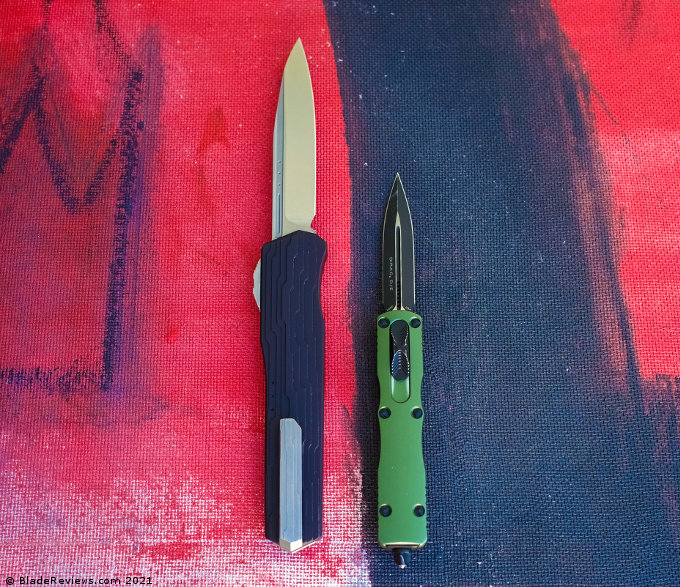
I personally find huge knives like the Microtech Cypher, Dirac Delta, and Combat Troodon to be unnecessarily large for anyone who doesn’t have giant sausage fingers, but what does necessary have to do with expensive switchblades? That’s my Cypher in the picture below, and I love that thing despite the fact that it makes me look like I have baby hands.
I’m always interested in the origins of names, and Microtech specializes in badass aggressive ones: The HALO, named after the US special forces High Altitude Low Opening skydiving technique, the now-discontinued Nemesis, named after the Greek mythological spirit of divine retribution, and the Troodon, named after an 11 foot tall bird-like dinosaur. I therefore naturally assumed that the Dirac and its larger variant, the Dirac Delta, were named after a bareknuckle boxer or something. I emailed Microtech customer service and was told this: “As far as the name DIRAC goes, it is actually a mathematical term. Dirac Delta is the “function”… represents an impulse.” It’s named after a math equation. WTF? I then actually did some research, and the aforementioned theory is by Nobel Prize-winning theoretical physicist Paul Adrien Maurice Dirac (1902-1984) who predicted the existence of antimatter. Antimatter is definitely badass, so Dirac is still a cool Microtech name, but it’s a thinker…
Handle, Ergonomics, and Pocket Clip
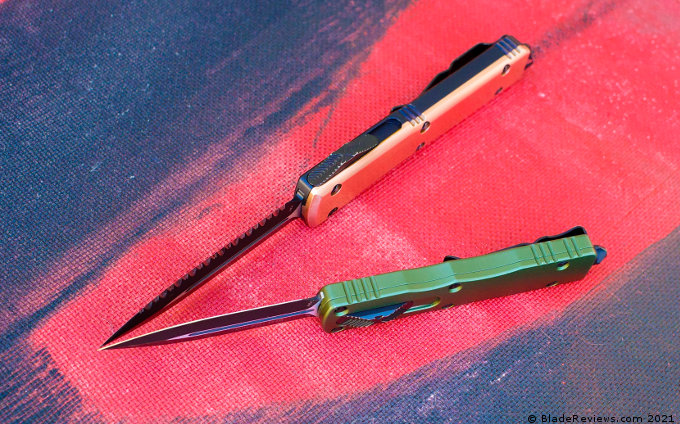
The ergonomics are what initially attracted me to the Dirac. Before I bought my Dirac I had the opportunity to handle a Benchmade Infidel at SHOT Show 2020 and in the context of fiddling with it at Benchmade’s booth, I knew I intuitively liked the ergonomics of its top-mounted slider, but couldn’t quite explain why. When I got my Dirac and started EDC-ing it, I discovered the huge advantage of a top-mounted slider vs. a standard OTF spine-mounted slider:
When pulling the Dirac out of my pocket, I pinch the knife between my thumb, which slides into my pocket, and the middle joint of my index finger, which is below the tip of the pocket clip. It’s a pretty deep grip- my thumb is on the top slider, and my index finger is just as far forward on the back side. This deep drawstroke allows me to open the blade and use the knife without adjusting my grip. I can’t think of any other style of folding knife that allows for instant use right out of the pocket. Spine-mounted sliders require a grip adjustment to get your thumb on the switch, and any non-OTF knife (even ones with the Emerson Wave opening feature) require your fingers to get out of the way when the blade swings out.
As I was figuring out the mechanics of this draw, it felt a little un-natural using a knife with my thumb on the flat side of the knife instead of the spine. I realized the awkwardness was because I had extensively used single edged knives- I hold single edge knives with my thumb on the spine in a “forehand” style when cutting left to right, or I flip my hand over into a “backhand” style when cutting right to left. With a double edged knife, there’s no need to flip my wrist over to change cutting direction- there’s blade on either side, and my thumb can just sit in the middle and drive the knife left or right with equal ease.
I used this grip style to destroy a large stack of cardboard boxes, and the only problem I had was that the “shoulder” of the pocket clip (see circle on pic below) created an uncomfortable hot spot on my hand fat.
The most comfortable grip of all was with the slider facing my palm, which further reinforces the utility of double-edged knives: it doubles the practical grip options.
The Dirac is Microtech’s first new OTF design in several years, and although it’s clearly in the Microtech in-house design style, there are some subtle improvements to the handle and slider that I noticed in my obsessive examination of the knife.
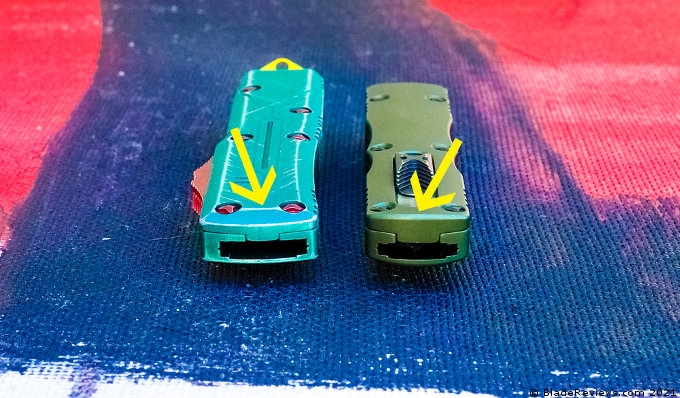
The top and bottom of the handle are convex instead of flat, which adds to the Dirac’s pleasant feel in the hand. It’s hard to see in the picture, but it’s easy to feel.
The Dirac’s jimping pattern is less sharp. On every other OTF except the Combat Troodon, the jimping pattern is two or three little narrow close-together scoops, then a little plateau, then more close-together scoops. The Dirac’s jimping pattern more spaced out. It’s a little less grippy than other Microtechs, but more comfortable when I have a tight grasp on the handle.
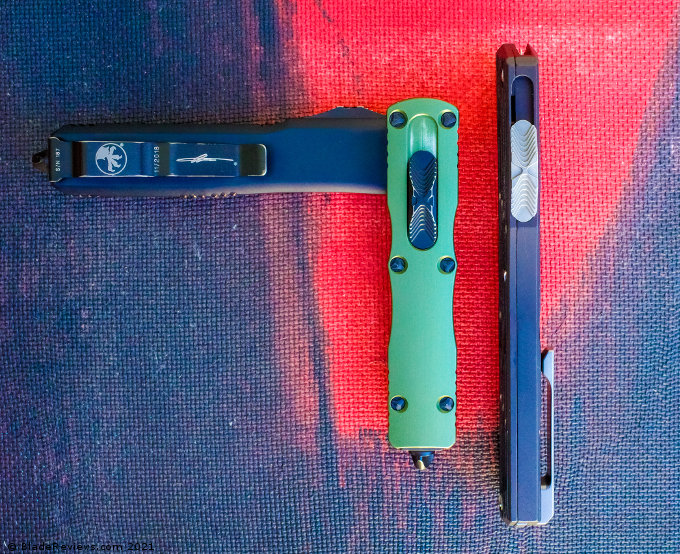
The slider now has angled sides instead of the classic flat sides like the Ultratech and Cypher in the picture, providing more contact surface area with fewer sharp edges, which makes it noticeably more comfortable to use.
The Dirac’s pocket clip is similar to Microtech’s normal bent steel double-dip clip, but there are small improvements here as well.

The simple genius of the double-dip clip is a higher section at the base of the clip near the glassbreaker that’s designed to loosely sit over the thick, folded seam at the top of a pants pocket, but still have good retention due to the lower, tighter section below it. Compared to the Ultratech clip (left) the Dirac can ride lower in the pocket because it doesn’t have a useless little tight section between the glassbreaker and the high section of the double dip. The clip works very well on the Dirac, which is rather light at 2.27 oz (64.4 g). My copper Ultratech, which weighs more than twice as much at 4.95 oz (140.5 g) has a similar clip, but due to it’s heavy copper top, I feel like the clip barely keeps it in place when I’m horizontal or upside-down. My Chris Reeve Knives Sebenza (another somewhat heavy knife) came with a similar double-dip style clip, and I had the same retention problem with it. I was so afraid of losing my fancy Large Sebenza that I went to the Chris Reeve Knives website and ordered a Hawk Pocket Clip (pictured below), which requires the user to pinch the little lever with the hole in it to open the tip of the clip, resulting in a very secure grip.
In case any of my hard-core knife nerd brothers are wondering, my Sebenza is technically a Chris Reeve/Wilson Combat collaboration knife called the “Star-Benza 21” with the optional Insingo blade shape. The only way this differs from a regular CRK Sebenza (besides costing $50 more) is the groovy Wilson Combat machined starburst pattern on the scales and the Wilson Combat logo on the clip, which I swapped out for the Hawk clip.
One other difference between the Dirac and most other Microtech knives is the clip doesn’t have the little lanyard hole that virtually no one uses.
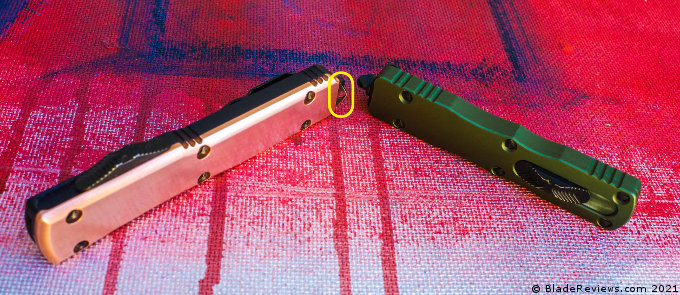
I did a Google image search for “Microtech OTF” and found 19 million pictures of Microtech OTF knives, but not a single one with a lanyard attached. I then did a search for “Microtech OTF lanyard” and of the 19 billion pictures, I found 6 knives with lanyards. That’s 6 out of 19 trillion. My scientific research indicates it was a smart move by Microtech to remove a feature that was used by only 6 out of 19 gazillion people.
Deployment and Lockup
The deployment is the reason I bought this knife- it’s magically delicious. The lockup, which has wiggly blade play in two directions, is the price you pay for the awesome deployment. If this were a manual folding knife, I wouldn’t accept this much blade play in a $10 gas station folder, much less one that cost $270 like my Dirac. Unless you drop $2,500 for a G&G Hawk Deadlock OTF (made by the designers of the CRK Hawk clip on my Sebenza, by the way) your OTF is going to have lots of blade wiggle. Therefore, the only fair lockup comparison I can make is is against other OTF knives, and I don’t have any non-Microtechs to compare to the Dirac.
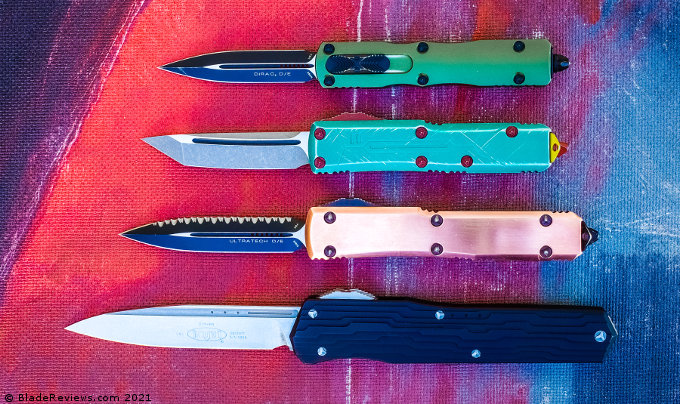
The other three Microtechs I have on hand also all have blade wiggle in one vertical direction (up) and one horizontal direction (right). My memories of handling a few Benchmade Infidel and Autocrat OTFs 11 months ago aren’t super sharp, other than noting that they had blade wiggle too and that the Benchmade switches were significantly easier to actuate than any Microtech I’ve handled. I personally prefer the heavier Microtech trigger weight because I don’t want any auto knife unintentionally opening in my pocket.
The Dirac, like all other Microtech OTF knives other than the HALO, are designed to basically fall off their coiled spring train tracks if the knife encounters resistance during deployment. Launching the blade into something as soft as a piece of thick paper is enough to stop the blade from fully extending, and the blade has to be manually pulled out to get back to its normal functioning state. The HALO has no such safety feature, and is meant to be carried in a sheath. It deliberately doesn’t have a pocket clip to try to discourage people like my friend Shaun from pocket carrying it. Shaun’s HALO opened in his pocket and luckily it just ripped a hole in his pants instead of in his femoral artery.
I don’t have a way to measure the pounds-per-inch of force to move the slider on my Dirac, but it’s heavy enough to require deliberate effort to deploy or retract, and it’s not so stiff that I can’t easily manipulate it. My Cypher’s spring is so strong (perhaps because it’s a significantly longer and thicker blade) that I can barely close it with one hand, and it leaves a dent in my thumb. Microtech seems to have a lot of variation in their slider tension and whether the slider rattles.
My Dirac’s slider doesn’t make a sound, my Ultratech’s slider rattles when the blade is out but not when it’s in, and the UTX-85’s slider rattles all the time. I know that the coiled spring that powers the action is at rest in both the open and closed positions, but why the slider would be loose on some individual knives is beyond my understanding. I do know that it doesn’t seem to affect mechanical performance.
Regarding mechanical performance, The Dirac is my least expensive, still-in-production (AKA replaceable) OTF knife, so I really worked this knife hard, using it for tasks I wouldn’t ordinarily touch with any of my other OTF knives. While cutting cardboard and plastic, I put so much pressure on the blade edges that several times I thought the blade might snap out of the handle. It held up perfectly and the deployment is unchanged after months of use.
Microtech Dirac Review – Final Thoughts
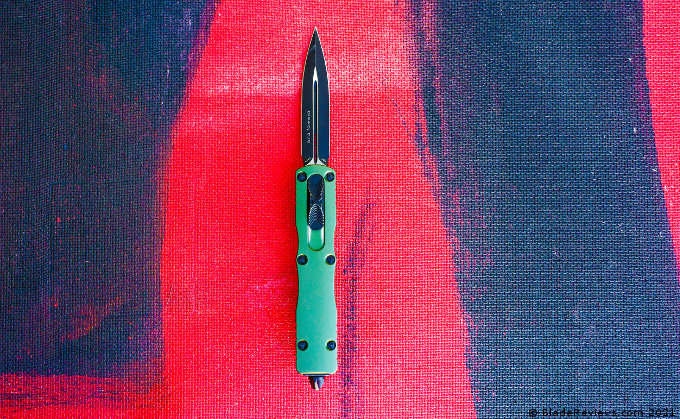
I’ve had a few side-opening switchblades over the years (in fact I just got the Kershaw Launch 13 side-opening switchblade for an upcoming review) and I used to think their level of convenience and ease of use was unmatched. But after carrying and really using the Dirac, I found the form factor of this small OTF knife to be ideal in almost every way. I absolutely love the one-handed ease of use of an OTF knife- the instant it clears the top of my pocket it’s ready for use, and it’s just as easy to put away. The Dirac’s size and shape are well-suited to most tasks I encounter in my life, the M390 blade steel keeps a sharp edge for a very long time, and I consider the handle length of four inches (0.22 Biblical Cubits) to be the minimum usable length for my medium-large hands. By the way, the Microtech UTX-85, which is comparable in size to the Dirac, is generally thought of as an 85% size version of the Ultratech (thus the 85 in its name) but that 85% number only refers to blade length, since the UTX-85 is dimensionally nearly identical to the Ultratech in everything except length. The Microtech UTX-70, however, is actually smaller in all dimensions than an Ultratech. Fun fact? It’s fun for me at least.
I’ve only found three real downsides to carrying the Dirac:
- There’s no quiet way to open the knife, other than fake coughing to cover the sound of the addictive in-out-in-out-in-out (until your significant other tells you to stop it with the fuckin’ clicking!)
- If the blade has food or tape residue on it, I try to not retract the blade until I clean it because there are parts inside the handle that don’t like sticky goo.
- OTF knives seem to be extra scary to non-knife people, at least in my beloved Los Angeles. The other day I was picking up a big bag of vegan fast food at Veggie Grill, where they tape up the takeout bags (to keep the COVID out I guess) and out came the Dirac to cut the tape and check my order. I am not a person who derives pleasure from other peoples pain, but I must say that the looks of shock I saw on the faces of the two employees behind the counter was… satisfying. Sorry not sorry.
Oh yeah, and switchblades are illegal in a bunch of places, so that’s another thing to keep in mind. What I primarily keep in mind however, is that I never, ever, ever, get tired of doing the Dirac’s magic trick.
Thank you to Sara O’Neil for the use of her painting.
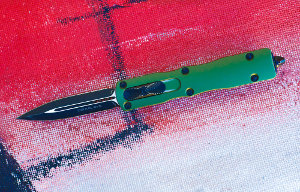
Microtech Dirac – From $280.00
From: BladeHQ
Editor: I recommend purchasing the Microtech Exocet at BladeHQ. Thank you for reading.
